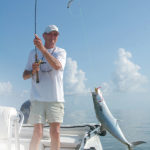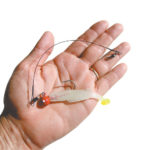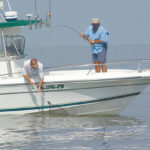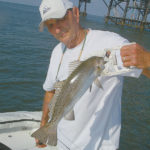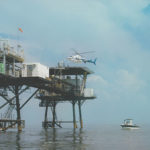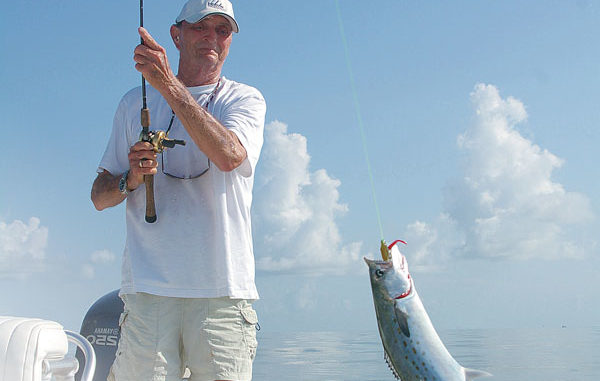
EI-74 ground zero for excellent Spanish mackerel action
A drip of sweat somehow traveled along the Neanderthalic eyebrow-hidden bumps of my forehead and passed down the lens of my cheater eyeglasses. The sweat stung my eye, blurred my vision and complicated my efforts to thread some monofilament through the eye of a 3/8-ounce jighead.
With the cheaters slid half way down my nose, exasperated and in utter frustration, I looked over the top of them at my friend Danny Womack, who was staring at me with the same kind of look. In that instant I should have found his situation somewhat comical, but I couldn’t muster even the slightest grin.
In his mouth was a ½-ounce jighead connected to a swivel, obviously there to free up his hands. In one hand he held a second jighead and in the other the end of a length of line also connected to the swivel that he was trying to thread through the jig’s eye.
With sweat pouring off his head, he tried to rub it off with the back of his wrist so as not to stick himself in the eyeball with the business end of the jig.
Like I said, under normal circumstances we should have been laughing about our plight, but I was rigging my line for the sixth straight time in subsequent casts, and Womack probably the same.
“What the heck keeps cutting our lines,” I asked my friend, while lamenting about the tackle we were wasting without a fish to show for it.
“It’s either sharks or Spanish mackerel — probably mackerel,” said Womack, who commonly rigs his line using a two jighead set up.
“Well, let’s catch ’em!” I stated with sort of a payback resolve in mind and in my voice.
Having never caught a Spanish mackerel before, I was anxious to hook one of the ruthless demons. Offshore production platform EI-74 out in Eugene Island was just the place to make it happen; only we’d have to use something to get around a Spanish mack’s razor-sharp teeth.
The way we were rigged for speckled trout didn’t include any steel leaders, nor did either of us happen to have anything in our respective tackle boxes to remedy the situation that day — we’d have to wait a week.
“They’re definitely fun to catch!” says Harry Blanchet, marine biologist for the Louisiana Department of Wildlife and Fisheries. “Like their close relative, king mackerel, they have teeth, and if you’re not ready, they will cut your line. They’re not timid. A mackerel is a lot more aggressive fish, but all you have to do is put a wire in your line.”
Midweek, Womack came by my office and laid a small paper sack on the desk in front of me. Its contents included a small handful of ½-ounce jigheads and a couple packages of black vinyl-coated steel leaders, 9 inches long and ready to go.
“So this is the ticket?” I asked, while pulling one of the leaders out of its wrapper so I could touch, feel and envision how this was all going to work.
“That’s what we used to use,” he replied.
“So, what do I owe you?” I questioned.
His silent pause was followed by, “I’ll call you Friday afternoon after I check the weather. You want to meet at the same time and place?”
My friend was more interested in catching Spanish mackerel than a few bucks.
The plan was to hit a few of the rigs we normally do for trout on the way back out to EI-74, where the Spanish macks attacked us the week prior.
Those who fish EI-74 know the location is an extended run, well beyond some of the closer-in rigs that rest in shallower water. The water below many of Eugene Island’s closer-in rigs happens to be in the 12- to 15-foot range. EI-74 is located farther out in deeper water that’s less influenced by the fresh, muddy water of the Atachafalaya River; therefore, it has higher salinity and more clarity.
Blanchet pointed out that the shallower rigs of Eugene Island where Womack and I fished for trout weren’t as likely to have Spanish mackerel when compared to the deeper water, where there is more stratification in the water column.
“Typically in 12 to 15 feet of water, you’re not going to have as much mixing as you will if you’re out in a little bit deeper water,” the biologist explained. “Depending how close you are to the mouth of the river, you can have a layer of river water over some higher-salinity, clearer water. You might have a thin layer of low-salinity water and fish associated with that water.
“Below that, you may have a whole different suite of species that would be associated with coastal waters with higher-salinity, clearer water. But you see that in areas that may be 30-feet deep. Even with 15 or 20 feet of water, you can see some stratification.”
Someone who has fished Eugene Island extensively most of his life is Marty Scelfo, owner of Scelfo’s Sporting & Marine in Franklin. Scelfo is familiar with mack attacks, and knows they’re typically found in deeper water.
“The majority of people I know who fish Spanish mackerel run to waters more like where you’ll find king mackerel,” he said. “And normally it’s going to be around the fringes of where you find speckled trout. If you run into bluefish, you’re going to run into Spanish mackerel because they’re going to be right next to them — 74 is right on the fringes of speckled trout waters. The water is a little deeper there than, say, where 51 was and 65.”
Spanish mackerel were never the targeted fish of any trip I accompanied Womack on in the past. Our goal was always to catch speckled trout. But the excursion out to EI-74 was a semi-targeted trip. We’d fish for trout, but went prepared for Spanish macks, with the intention of landing a few.
“If you want to target Spanish mackerel you’re probably going to want to be a bit farther offshore than Eugene Island,” Blanchet said. “They typically are going to be found in water a bit deeper — and again depending on salinity — anywhere from 30 to 100 feet or so.
“You’ll find them in deeper water, but if you’re at a rig in 150 feet of water, they’ll probably be in the top 50 feet of water or so.”
Armed and dangerous, Womack and I headed out on a routine patrol of trout fishing in Eugene Island hitting blocks 52, 63 and 65 before making the push out to EI-74, where the Spanish-mack ambush took place the week prior. We hadn’t picked up but a couple of trout and, quite honestly, the nature of my partner is to not hang around a platform where it isn’t happening.
That suited me just fine. I wanted to hit those mackerel that set our lines adrift the week before.
Other boats surrounded the rig when we got there. And, from what I could tell, various levels of catching were taking place that included trout and Spanish. As normal, I hadn’t tied the bowline completely yet before Womack was making his first cast behind the boat. Then I made mine.
Just underneath the surface of the greenish-blue water, like a torpedo on steroids, my first Spanish mackerel ever raced with the moving tide beneath the rig. Its reflection was stunning, and the fight it put up was more satisfying than the steady catch-and-reel activities associated with boating trout.
Like with all firsts, I studied the species closely. Its color, shape and razor teeth were intriguing. This fish was designed to kill and feed on schools of baitfish. And it destroyed my 9-inch leader, leaving it functional but not without kinks and the vinyl coating cut to shreds. My friend had made the right call with us adding this little piece of insurance to our lines and jigheads.
ugene Island block 74 is a 35- to 40-minute boat ride from Burns Point, and approximately the same — give or take — from Cypremort Point. Much will depend on weather, watercraft and your trip plan.
But if offshore saltwater anglers are looking to disrupt a mack-attack ambush just for grins while doing a little speck fishing, EI-74 just might be the right destination to do both.
